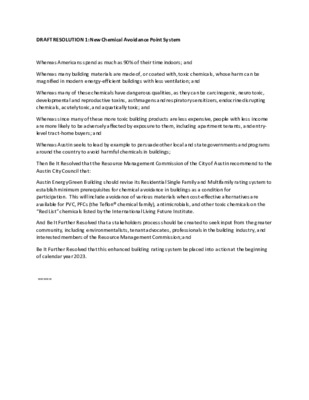Item 9: Draft Resolutions- Toxic Materials in Buildings — original pdf
Backup

DRAFT RESOLUTION 1: New Chemical Avoidance Point System Whereas Americans spend as much as 90% of their time indoors; and Whereas many building materials are made of, or coated with, toxic chemicals, whose harm can be magnified in modern energy-efficient buildings with less ventilation; and Whereas many of these chemicals have dangerous qualities, as they can be carcinogenic, neurotoxic, developmental and reproductive toxins, asthmagens and respiratory sensitizers, endocrine disrupting chemicals, acutely toxic, and aquatically toxic; and Whereas since many of these more toxic building products are less expensive, people with less income are more likely to be adversely affected by exposure to them, including apartment tenants, and entry- level tract-home buyers; and Whereas Austin seeks to lead by example to persuade other local and state governments and programs around the country to avoid harmful chemicals in buildings; Then Be It Resolved that the Resource Management Commission of the City of Austin recommend to the Austin City Council that: Austin Energy Green Building should revise its Residential Single Family and Multifamily rating system to establish minimum prerequisites for chemical avoidance in buildings as a condition for participation. This will include avoidance of various materials when cost-effective alternatives are available for PVC, PFCs (the Teflon® chemical family), antimicrobials, and other toxic chemicals on the “Red List” chemicals listed by the International Living Future Institute. And Be It Further Resolved that a stakeholders process should be created to seek input from the greater community, including environmentalists, tenant advocates, professionals in the building industry, and interested members of the Resource Management Commission; and Be It Further Resolved that this enhanced building rating system be placed into action at the beginning of calendar year 2023. ===== DRAFT RESOLUTION 2: New Chemical Avoidance Point System Whereas Americans spend as much as 90% of their time indoors; and Whereas many building materials are made of, or coated with, toxic chemicals, whose harm can be magnified in modern energy-efficient buildings with less ventilation; and Whereas many of these chemicals have dangerous qualities, as they can be carcinogenic, neurotoxic, developmental and reproductive toxins, asthmagens and respiratory sensitizers, endocrine disrupting chemicals, acutely toxic, and aquatically toxic; and Whereas since many of these more toxic building products are less expensive, people with less income are more likely to be adversely affected by exposure to them, including apartment tenants, and entry- level tract-home buyers; and Whereas Austin seeks to lead by example to persuade other local and state governments and programs around the country to avoid harmful chemicals in buildings; Then Be It Resolved that the Resource Management Commission of the City of Austin recommend to the Austin City Council that: Austin Energy Green Building should revise its Residential Single Family and Multifamily rating sys tem to create a new point category for removing dangerous chemicals from buildings. This will include prerequisites and points that currently exist in the current program pertaining to harmful chemicals such as low-VOC paints, but will also include new points for avoidance of various materials that contain PVC, PFCs (the Teflon® chemical family), antimicrobials, and other toxic chemicals on the “Red List” chemicals listed by the International Living Future Institute. For each of the five AEGB “Star” levels, the number of points that need to be attained for chemical avoidance should be increased. And Be It Further Resolved that a stakeholders process should be created to seek input from the greater community, including environmentalists, tenant advocates, professionals in the building industry, and interested members of the Resource Management Commission; and Be It Further Resolved that this enhanced building rating system be placed into action at the beginning of calendar year 2023.